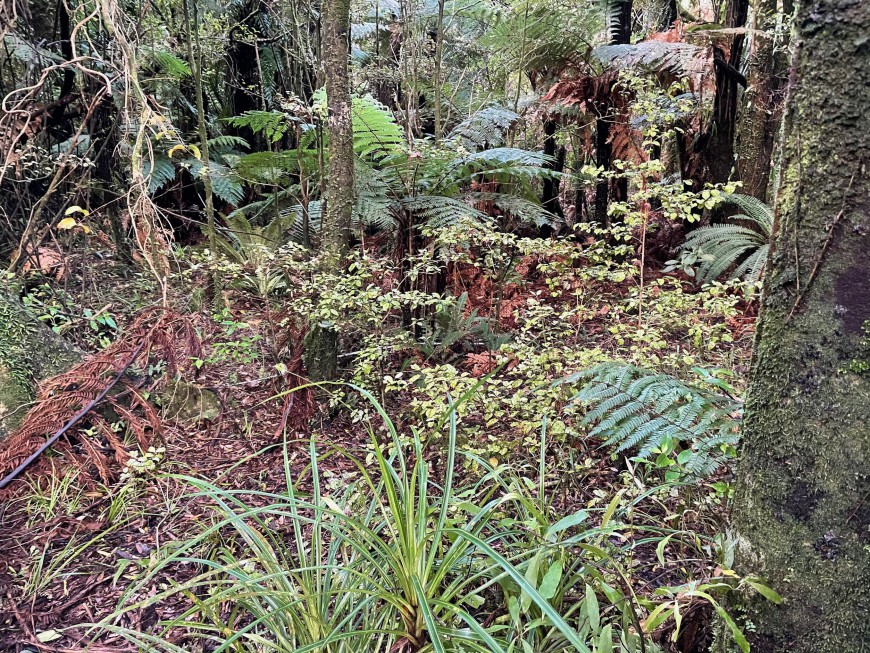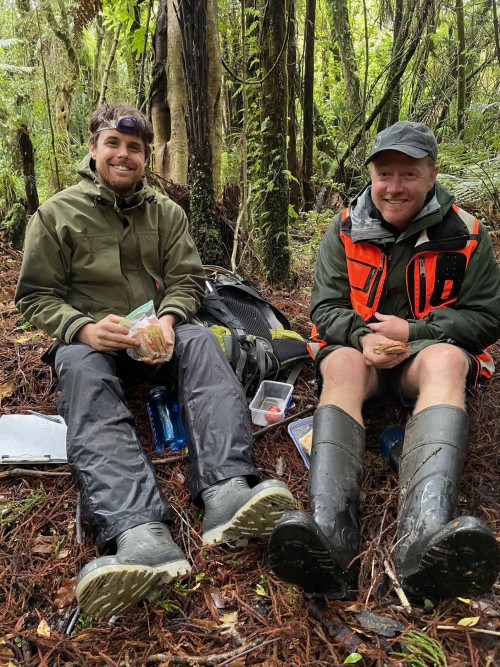Field work season ramping up for the Beyond Myrtle Rust programme

Young Lophomyrtus bullata (ramarama) plants in dense Taranaki forest, awaiting examination by the Beyond Myrtle rust team.
After a year of interruptions by COVID-19 lockdowns, researchers from the ‘Ecosystem Impacts’ research aim of the Beyond Myrtle Rust Programme are embarking on the first fieldwork season of 2021. Dr Mahajabeen Padamsee, Beyond Myrtle Rust research programme lead and research mycologist at Manaaki Whenua – Landcare Research, is particularly excited about this field season.
“All of our previous fieldwork efforts have been to establish the framework for collecting samples,” says Padamsee. “This season we actually get to go in and collect our samples and find out more about the state of our ecosystems.”
In late January, researchers will be heading to Shakespear and Tāwharanui Regional Parks to collect soil samples from mānuka plots. Last year, the team identified eight 20 × 20 m plots in both parks – four plots with naturally regenerating forest and four with planted stands of mānuka.
“The reason why we are looking at these two forest types is that mānuka is planted across New Zealand for restoration,” says Padamsee. “We’d like to know if ecosystems with planted mānuka are as healthy as naturally regenerating ecosystems.”
Last year, adult mānuka plants in each of these plots were tagged and measured, and all saplings were counted. This year the team is collecting soil samples from these plots.
“Soil is an important factor for a healthy, functioning ecosystem,” says Padamsee. “These plots can be used to establish a baseline of what healthy soil looks like for the region.”
One of the many things they will be measuring in the soil is the microbial community.
“We’ll be using DNA sequencing methods to determine species of microbes present in the soil,” says Padamsee.
Another way to assess soil health is looking at earthworm biodiversity.
“If you are finding native earthworms, not just European earthworms, then you know the soil is healthy and relatively undisturbed.”
Fieldwork is also planned for a research project being conducted in Taranaki, focusing on ramarama (Lophomyrtus bullata). This study is looking to see if ramarama infection varies across a gradient from the edge of a forest to the interior, known as an edge effect.

Manaaki Whenua researchers James McCarthy and Alex Fergus take a break from setting up their field sites in Taranaki.
“Specifically, we want to know if the disease is more severe on the edges of the forest and less severe deeper in the forest, or if the disease is spread in a fairly uniform way,” says Padamsee.
Researchers have measured all of the ramarama, and tagged a subset, in a transect made up of multiple small plots. This season, soil and leaf samples are being collected. Climate data, co-occurring flora, and infection levels of the plants over time are being recorded.
“This will help us construct a three-dimensional view of the factors responsible for protecting plants from this disease,” says Padamsee.
Leaf samples are also being taken to identify the microbiome of the plants themselves.
“We are hoping that there may be some microbial species in the microbiome of healthy plants that can be used to protect other plants in other locations,” says Padamsee.
After a season of meticulously collecting samples, researchers will return to their labs to process them, and piece together a broader understanding of the impact this disease is having on New Zealand’s ecosystems.
For more information about the Beyond Myrtle Rust ‘Ecosystem Impacts’ research area, see here.